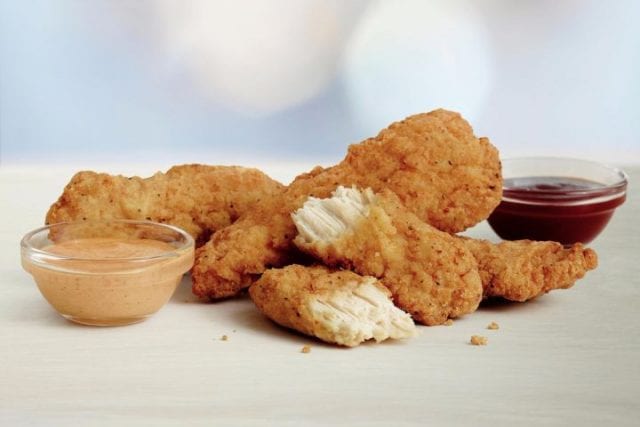
May 14, 2011. St. Louis. (ONN) A few days ago, Gannett News Service published a story asking, ‘What’s in a chicken nugget?’. At first glance, the reader might thing the story was referring to the one and only ‘Chicken McNugget’ from McDonalds. After all, it’s not called a chicken strip, finger, tender or any of the other generic names for the popular food. Instead, it was called a ‘nugget’.
Upon further inspection however, no mention is made anywhere of the name McDonalds or Mc-anything. With that said, the findings from Gannett truly are food for thought, or 53 percent food anyway. That was the result from independent food safety auditors Microbe Inotech Laboratories according to Gannett – a chicken nugget is only 53 percent chicken meat. Less expensive chicken nuggets are suspected of containing even less meat.
‘Retired egg layers’ – that’s what every newspaper in the country told us is the base ‘meat’ of a chicken nugget. ‘What the heck is a retired egg layer’ you ask? We at Whiteout Press wondered the same thing. Traveling all the way to Ireland to find the answer, retired egg layers are what they call decrepit old birds that are too old to be useful, but not quite dead yet.
Anyone remember the animal rights footage of California’s happy dairy cows being rolled, half-dead, into the slaughterhouse by a fork-lift because California law prohibits the use of dead cows in our food supply and requires all cows be able to walk into the slaughterhouse on their own? With the government inspector looking on, sick, crippled and dead cows were rolled right on into our nation’s supply of dirt-cheap school lunches. Using ‘retired egg layers’ sounds suspiciously similar to the happy cows above.
Aside from the retired egg layers, the 53 percent ‘chicken meat’ is also reported to consist of all the left-overs such as tendons, tissue, cartilage, organs and other ‘parts’. As the story explains, the parts and pieces are “ground into a fine poultry paste. Because that paste is typically crawling with bacteria, it’s washed with ammonia, and treated with an artificial flavoring. To get rid of the pink color, the paste is dyed”.
But what’s in the other 43 percent of a chicken nugget? The story doesn’t say. And while we’re on the subject, what’s in the famous Chicken McNugget? For those answers, we headed to Al Nye The Lawyer Guy. There, he sites Michael Pollan’s book The Omnivore’s Dilemma which details the eating habits of Americans.
One interesting fact is that a McNugget is 56 percent corn. Aside from that, there are 37 other ingredients. The following is taken directly from Al Nye The Lawyer Guy and The Omnivore’s Dilemma:
“The ingredients listed in the flyer suggest a lot of thought goes into a nugget, that and a lot of corn. Of the thirty-eight ingredients it takes to make a McNugget, I counted thirteen that can be derived from corn: the corn-fed chicken itself; modified cornstarch (to bind the pulverized chicken meat); mono-, tri-, and diglycerides (emulsifiers, which keep the fats and water from separating); dextrose; lecithin (another emulsifier); chicken broth (to restore some of the flavor that processing leeches out); yellow corn flour and more modified cornstarch (for the batter); cornstarch (a filler); vegetable shortening; partially hydrogenated corn oil; and citric acid as a preservative. A couple of other plants take part in the nugget: There’s some wheat in the batter, and on any given day the hydrogenated oil could come from soybeans, canola, or cotton rather than corn, depending on the market price and availability.
According to the handout, McNuggets also contain several completely synthetic ingredients, quasi-edible substances that ultimately come not from a corn or soybean field but form a petroleum refinery or chemical plant. These chemicals are what make modern processed food possible, by keeping the organic materials in them from going bad or looking strange after months in the freezer or on the road. Listed first are the “leavening agents”: sodium aluminum phosphate, mono-calcium phosphate, sodium acid pyrophosphate, and calcium lactate. These are antioxidants added to keep the various animal and vegetable fats involved in a nugget from turning rancid. Then there are “anti-foaming agents” like dimethylpolysiloxene, added to the cooking oil to keep the starches from binding to air molecules, so as to produce foam during the fry. The problem is evidently grave enough to warrant adding a toxic chemical to the food: According to the ‘Handbook of Food Additives’, dimethylpolysiloxene is a suspected carcinogen and an established mutagen, tumorigen, and reproductive effector; it’s also flammable.
But perhaps the most alarming ingredient in a Chicken McNugget is tertiary butylhydroquinone, or TBHQ, an antioxidant derived from petroleum that is either sprayed directly on the nugget or the inside of the box it comes in to “help preserve freshness.” According to ‘A Consumer’s Dictionary of Food Additives’, TBHQ is a form of butane (i.e. lighter fluid) the FDA allows processors to use sparingly in our food: It can comprise no more than 0.02 percent of the oil in a nugget. Which is probably just as well, considering that ingesting a single gram of TBHQ can cause “nausea, vomiting, ringing in the ears, delirium, a sense of suffocation, and collapse.” Ingesting five grams of TBHQ can kill.”
Food for thought, just not for eating.





